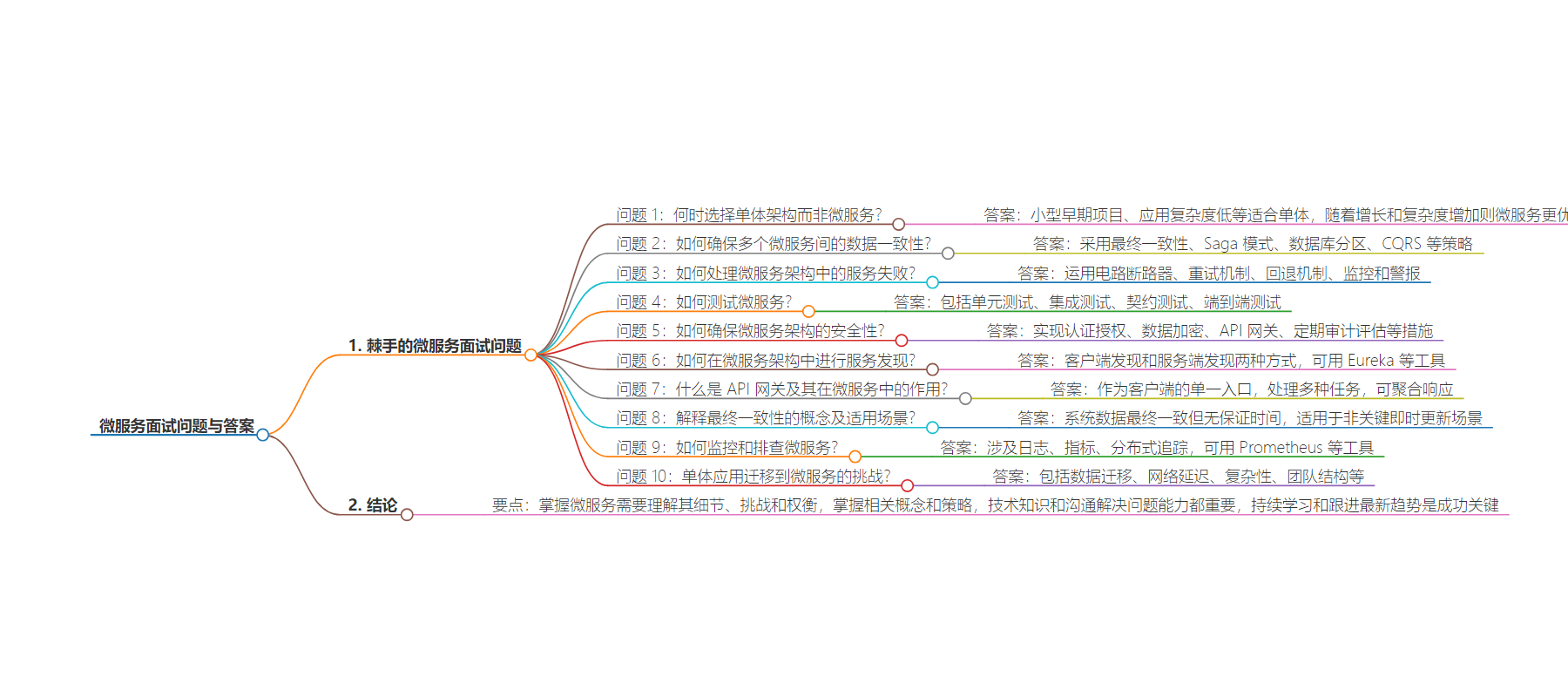包阅导读总结
1. 关键词:Microservices、Interview Questions、Architecture、Consistency、Challenges
2. 总结:本文围绕微服务的棘手面试问题及答案展开,介绍了微服务架构在现代软件开发中的重要性,探讨了应对面试中各类微服务相关问题的方法和策略,强调掌握相关知识和技能对成功的重要性。
3. 主要内容:
– 微服务架构已成为现代软件开发基石,面试需深入理解其复杂与挑战
– 棘手面试问题
– 何时选择单体架构而非微服务
– 如何确保多微服务间数据一致性
– 怎样处理微服务中的服务失败
– 如何测试微服务
– 如何确保微服务的安全性
– 如何处理微服务中的服务发现
– API网关及其作用
– 解释最终一致性概念及适用场景
– 如何监控和排查微服务问题
– 单体应用迁移到微服务的挑战
– 结论
– 掌握微服务需深入理解其细节、挑战和权衡
– 掌握相关概念能更好应对问题
– 技术知识、沟通和解决问题技能重要,持续学习跟上趋势是成功关键
思维导图:
文章来源:javacodegeeks.com
作者:Eleftheria Drosopoulou
发布时间:2024/8/15 17:14
语言:英文
总字数:869字
预计阅读时间:4分钟
评分:87分
标签:微服务架构,软件开发,分布式系统,容错性,测试策略
以下为原文内容
本内容来源于用户推荐转载,旨在分享知识与观点,如有侵权请联系删除 联系邮箱 media@ilingban.com
Microservices architecture has become a cornerstone of modern software development. However, cracking a microservices interview requires a deep understanding of its intricacies and challenges. This article delves into the most challenging questions you might encounter and provides insights into crafting effective responses. This guide will equip you with the knowledge to excel in your next interview.
1. Tricky Microservices Interview Questions
Question 1: When would you choose a monolithic architecture over microservices?
This question tests your understanding of the trade-offs between monolithic and microservices architectures.
Answer:
While microservices offer many advantages, they also introduce complexity and overhead. A monolithic architecture might be suitable for small, early-stage projects where simplicity and rapid development are prioritized. Additionally, if the application has low complexity, tight coupling between components, and infrequent updates, a monolithic architecture could be more efficient. However, as the application grows and complexity increases, microservices become a more viable option.
Question 2: How do you ensure data consistency across multiple microservices?
This question assesses your understanding of distributed systems challenges.
Answer:
Maintaining data consistency across microservices is a complex issue. Strategies include:
- Eventual consistency: Using event-driven architectures and ensuring eventual consistency through idempotent operations.
- Saga pattern: Orchestrating transactions across multiple services, ensuring data consistency through compensating transactions.
- Database partitioning: Carefully partitioning data to minimize distributed transactions.
- CQRS (Command Query Responsibility Segregation): Separating read and write models to improve scalability and consistency.
Question 3: How do you handle service failures in a microservices architecture?
This question evaluates your knowledge of fault tolerance and resilience.
Answer:
Service failures are inevitable in a microservices architecture. Implementing robust error handling mechanisms is crucial. Key strategies include:
- Circuit breakers: Preventing cascading failures by isolating failing services.
- Retry mechanisms: Automatically retry failed requests with exponential backoff.
- Fallback mechanisms: Providing alternative responses or degraded functionality in case of failures.
- Monitoring and alerting: Continuously monitoring system health and implementing alerts for critical failures.
Question 4: How do you test microservices?
Testing microservices introduces unique challenges due to their distributed nature.
Answer:
A comprehensive testing strategy for microservices includes:
- Unit testing: Testing individual microservices in isolation.
- Integration testing: Testing interactions between microservices.
- Contract testing: Verifying that services adhere to their contracts.
- End-to-end testing: Validating the overall system behavior.
Question 5: How do you ensure security in a microservices architecture?
Security is paramount in microservices due to the increased attack surface.
Answer: Implementing robust security measures is essential:
- Authentication and authorization: Securely authenticate and authorize users and services.
- Data encryption: Protect sensitive data both at rest and in transit.
- API gateways: Enforce security policies at the edge.
- Regular security audits and vulnerability assessments: Identify and address potential security threats.
Question 6: How do you handle service discovery in a microservices architecture?
Service discovery is crucial for microservices to locate and communicate with each other.
Answer: There are primarily two approaches:
- Client-side discovery: Clients query a registry to find service instances. This approach offers more flexibility but can increase client complexity.
- Server-side discovery: A load balancer or API gateway handles service discovery, simplifying clients.
Popular tools like Eureka, Consul, and ZooKeeper can be used for service discovery.
Question 7: What is API Gateway and its role in microservices?
API Gateways are essential components of microservices architecture.
Answer: An API Gateway acts as a single entry point for clients, abstracting the complexity of the microservices behind it. It handles tasks like load balancing, authentication, authorization, rate limiting, and caching. It can also aggregate multiple microservices responses into a single response for the client.
Question 8: Explain the concept of eventual consistency and when it’s appropriate?
Eventual consistency is a consistency model where system data will eventually be consistent across all replicas, but there is no guaranteed time frame for this to occur.
Answer: Eventual consistency is suitable for systems that prioritize availability and partition tolerance over strong consistency. It’s often used in scenarios where data updates are not critical or immediate, such as social media feeds or e-commerce product catalogs.
Question 9: How do you monitor and troubleshoot microservices?
Monitoring and troubleshooting are critical aspects of microservices architecture.
Answer: Effective monitoring involves:
- Logging: Centralized logging for all microservices.
- Metrics: Tracking key performance indicators (KPIs) like response time, error rates, and resource utilization.
- Distributed tracing: Understanding request flow across multiple services.
Tools like Prometheus, Grafana, Jaeger, and Zipkin can be used for monitoring.
Question 10: What are the challenges in migrating a monolithic application to microservices?
Migrating to microservices is a complex process with various challenges.
Answer: Key challenges include:
- Data migration: Migrating data from a monolithic database to multiple microservices databases.
- Network latency: Dealing with increased network latency compared to a monolithic architecture.
- Complexity: Managing multiple services, their dependencies, and deployments.
- Team structure: Aligning teams with microservices boundaries.
2. Conclusion
Mastering microservices requires a deep understanding of its intricacies, challenges, and trade-offs. This article has explored some of the most challenging interview questions in the domain. By grasping concepts like service discovery, API gateways, eventual consistency, and testing strategies, you’ll be well-prepared to tackle complex microservices-related problems. Remember, while technical knowledge is crucial, effective communication and problem-solving skills are equally important. Continuous learning and staying updated with the latest trends in microservices architecture will be key to your success.
